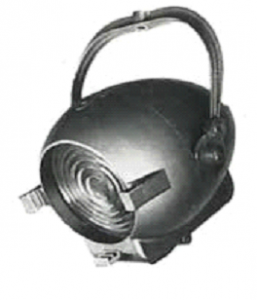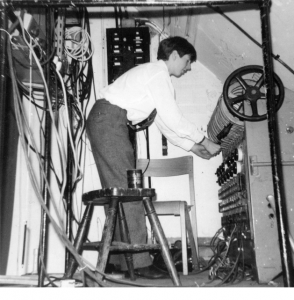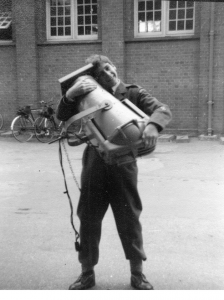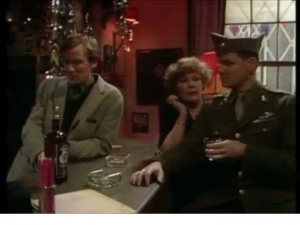Geoff Fletcher
How about "Lights we all remember"? I’ll kick off with the Sputnik and the Tenlight. Now where did I put my little brown book?
Peter Fox
-
Mole Richardson 612 Sputnik
-
Strand pat 243 Polestar also occasionally in derived versions as cloud projectors or followspots.
-
Strand pat 123 fresnel
-
Strand pattern 23 profile spot(both a bit small for main block TV but OK in Pres A/B or theatre (in the general sense))
-
Strand 93as a follow spot or slung, with a wooden handle on the back.
Pick any of these except Pat 93 as a web search for a reminiscent glimpse of some overpolished conversation pieces.
(Click on the picture below to see larger version:
use your Browser’s BACK button to return to this page)
Strand Pat 123
Mike Jordan
I was at my local church hall last Saturday for their “operatic” evening to de-rig our sound gear afterwards.
Guess what the main soloist spot on the FOH bar was?
Pat 23 of course!
Our lighting at school (back in 1964-ish) was mainly these with 123 Fresnels, Patt 37 floods, individual compartment ground row and slung rows. And, of course, a proper interlock board.
Great Days.
(Click on the pictures below to see larger versions:
use your Browser’s BACK button to return to this page)
Geoff Fletcher
Don’t forget the DC Brutes! (Mainly for film guys.)
John Howell (Hibou)
I remember the studio arc supplies running BP machines, but did we have any arc lanterns available? The supply, I think, was 110 Volts but what Amperage was possible?
Peter Fox
I have seen 10k arcs slung in the studio, but only a couple of times. Monochrome era and colour. Very blue light of course but that might have been a plus as harsh sunlight was wanted. Presumably the main idea would have been to get a single source with single shadows across a large set. As to 110V, the Mole crane was 110V dc and the back projection machines were happy with that 110V supply too. As to current available, no idea, except that chopping your own Mole power cable could be very exciting and made big holes in the wheel guards.
John Howell (Hibou)
John Treays lit the exteriors of “Romeo and Juliet” in TC1 with one or more 10ks but I don’t think they were arcs. I remember he briefed the boom ops with an air of finality that ‘that is the sun’.
It sounds Peter that you speak from experience regarding ‘big holes in the wheel guards’ ?
Peter Fox
Not personally while driving or riding on one, just being in the same room!
The mechanics used to put a lot of lunchtime effort into guard straightening so it didn’t happen very often. And then in the eighties Bill Marshal developed a sturdy plastic guard system that didn’t cut cables nor earth them, thus removing an interesting diversion. I was (in a captain-like fashion) responsible for pulling over Nigel Williams’ ped mounted EMI 2000. He looked a little taken aback and disbelieving for a moment or two.
I have a vague memory of Duncan Brown using a big arc when I was "visiting" other studios. He liked experimenting. I believe he used builder’s propane floodlights on location for “Jack the Ripper”. A 10k arc would use about 90 amps? I doubt our system would provide much more than that, maybe 100 amps per outlet but that’s a guess.
I have been reading Martin Kemptons’s brilliant tvstudiohistory.co.uk website hoping to find a clue but so far I have only spotted a reference to Lime Grove in later Gaumont British film days quoting 25 to 150 amps DC per studio for arc lighting, with an implied overall one and a half megawatts for a/c lighting and other things, but it’s not clear.
David Carter
Duncan Brown used an unglassed Brute on "Tales From Hollywood".
http://www.imdb.com/title/tt0105528/fullcredits?ref_=tt_ov_st_sm
The carbon arc created a better point source to realise the Edward Hopper like images he was trying to achieve. Les Lamont would know more.
Ian Hillson
Les Lamont, does indeed, know much, much more – he tells me that the Brutes used were of the "automatic" variety which allowed longer takes.
I wrote a tribute to Duncan http://www.imdb.com/name/nm0113471/ and his work in the STLD mag at the end of last year (plagiarising others work – thank you Les, Ian Dow, Kaye Brown, and others). I was Duncan’s VO on many things, and enjoyed every moment in his company.
Here’s an extract:
"…Interspersed with all this fun were dramas in the Performance series: “Absolute Hell” and “The Widowing of Mrs Holroyd” with other teams, and we then met up again for “Tales from Hollywood”.
Duncan had decided that he would light the latter in the style of the works of David Hockney and the American artist Edward Hopper, emptying Ewell public library of its entire stock of books on the subject in the weeks leading up to recording. In that time he immersed himself, and us, in the images he wanted to get on tape.
After a bit of pre-recording at Ealing Studios (still owned by the BBC back in 1992) including its tank, we assembled in TC6 to commit the drama to oxide. As some of the action was set in an early film studio, Brutes had been hired in as set dressing, but when a 110V generator truck pulled up in the TV Centre ring road outside our studio, it became apparent that Duncan intended using them in anger. Oh and Dedolights, of course – another favourite lamp of his.
To say we were lighting with mixed colour temperature would be an understatement: at times it looked like steel and rust, and the only way was to let them rehearse, light and then, just before recording, to white balance the cameras for that scene within that set. Added to this, Howard Davies needed to be happy with the constraints that arc lights put on his directing, regarding the length of time he could record before the carbon rods needed attention, and Alan Machin in sound tolerated the noise they made. You soon realised why they dubbed music over those early films.
Over the next few days we painted many Hockney’s and Hopper’s in Bob Crowley and George Kyriakides’s sets, plus a few that had not been painted before. Duncan rightly won a BAFTA for his lighting.
Kaye recounts the night of the 1993 awards. They had only just sat down. Duncan’s name was the first to be called.
The steps and rostrum floor were covered in Martac (other slippery surfaces are available). What could possibly go wrong? The nation was treated to the sight of Duncan gingerly sliding towards his award in shiny soled shoes like an Olympic skater – shoes which Kaye now tells me were bought for his 1964 wedding …”
Kaye adds: “He was passionate about art and used his knowledge and creativity to make some spectacular programmes in his career, and was utterly overwhelmed when he won that BAFTA.”
Dave "Weasel" Willson http://www.imdb.com/name/nm1261804/ was his VS and Pete Manuel his (newly appointed) SRM – a real baptism of fire, we had to keep moving the gene truck around the ring road near TC6 to annoy different offices each day!
Having said that Dave Willson was there, I’m beginning to doubt my failing memory – however, the IMDB entry http://www.imdb.com/title/tt0105528/fullcredits reminds me that Dave Chapman deserves an honourable mention for EEO model work, etc.
Barry Bonner
I worked with Duncan on "Absolute Hell", the set was not boom op friendly at all. At times a fourth wall came and went but with the usual friendly cooperation from Duncan we managed. The main club room at times housed the entire star studded cast all doing one-liners, not a boom shadow in site. I did have a bet with the director that we were bound to get a camera in shot in one scene but in spite of me freezing a frame at the dub showing the top of a camera in amongst the crowd he didn’t pay up!
"Absolute Hell" is available on BBC DVD 2425: "The Judi Dench Collection" in all good stores!
(Click on the picture below to see larger version:
use your Browser’s BACK button to return to this page)
Pat Heigham
Brutes:
As a TVC Sound man who defected to films, I can relate a couple of stories,
One of the first features I worked on was “Puppet On A Chain”, lit by Oscar-winning DoP Jack Hildyard (“Bridge on the River Kwai”).
The scene:
A flat in Amsterdam – Int. Night, but the curtains open to see outside.
Jack lit the houses on the opposite side of the canal with 14 brutes.
I guess the locals were sweet talked into having bloody great lights
shining in their windows!
And then:
“Alien”, Shepperton Studios, one of the last scenes where the creature is dangling below the engine exhausts – was lit by a bank of 16 brutes on a 4×4 scaffold rig to simulate a sun.
Oh, and in Hong Kong for “Man with the Golden Gun”, brutes were the only answer to counteract the shadows from strong tropical sunshine.
I always felt sorry for the sparks who staggered past with a brute on their shoulders, and humping the ‘rizzies’ (ballasts), which were welcome to stand astride on a cold winter’s exterior shoot.
The ‘mechs’ (motorized carbon feed) could be noisy, sometimes.
Dave Plowman
I well remember doing a single camera drama night shoot on a barge moored up on the Thames – beside Battersea power station. Big lighting pre-rig – for the approach to the barge, etc. And then the heavens opened. Genny soon gave up the ghost. Only lighting left was a dim flood light on the crane – nothing to do with us. Soldiered on until the wee small hours with reflectors, etc. Looked total sh***e so had to be re-shot.
Alasdair Lawrance
I once heard of a night shoot in the small bedroom over the staircase of a 1930s semi, which involved a floor stand with a large luminaire, not necessarily a Brute being bounced off the ceiling.
Sparks: "D’you think we’ve got enough light in here?"
Lighting supervisor: "Yeah, I think so. Why d’you ask?"
Sparks: "Your trousers are on fire!"
Mike Giles
I was on a fairly lengthy OB at Slimbridge, which involved some days of getting shots of this, that and the other bird arriving, departing, nesting and what have you, culminating in an interview with Sir Peter Scott in his studio cum library, which overlooked the lake and was the best spot for seeing the Bewick swans which were just arriving.
The window to the lake occupied the whole of one wall and our EMs had decided to get one of the studio LDs (or whatever they were called then) to light the interview. A lovely guy, H. H. Wells, as he was always credited, but plain Bert to everyone, duly set up a classic interview set up (no boom involved), with lamps whose name and number I cannot recall, but because of reflections in the huge plate glass windows, was forced to move the lamps closer to the edges of those very windows. Just before Sir Peter arrived, there was a loud "ping" and a significant crack appeared in the glass behind one of the lamps. Huge panic ensued and our interviewer was dispatched to delay Sir Peter, whilst the damage was inspected and lamps were moved yet again. The full length drapes had been pulled right back, but now they were decorously drawn, enough to hide the crack and Sir Peter was not informed until after the single on-site VT had done a full check of the interview.
The problem with replacing the glass was that no-one, but no-one was allowed lakeside of those windows whilst the Bewick swans were there and as they had only just arrived, that was going to be for some time.
I never did hear what colour Sir Peter went when he was informed!
Peter Hider
As part of my ‘can’t let go of my TV past completely’ bit, I’m the Facility Manager at a small local theatre in Crowthorne, Berkshire run by the East Berks Operatic Society, although this is a misnomer as we do musicals and straight plays but never opera.
I do the lighting on shows using a 50 year old Strand desk and, with the exception of a few new lamps that we bought about 5 years ago, lamps that came from the Apollo theatre in Slough when it closed. These must be 40 years old so I’m always looking for extra lamps.
Our limitation is the 64kw mains feed coming into the theatre so none of our lamps are bigger than 2ks.
We would love to go to a computerised system but the funds and installation manpower won’t run to it so for the moment our lighting rig is a remarkable working museum piece.







